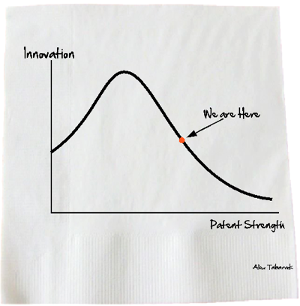In The Register, Tim Worstall explains why the notion of patents was introduced to the law and why we need to fix it now:
Having decided that the patent problem is an attempt to solve a public goods problem, as we did in part 1, let’s have a look at the specific ways that we put our oar into those perfect and competitive free markets.
It’s worth just noting that patents and copyright are not, absolutely not, the product of some fevered free market dreams. Rather, they’re an admission that “all markets all the time” does not solve all problems. That exactly why we create the patents.
Given that people find it very difficult to make money from the production of public goods, we think that we probably get too few of them. Innovation, the invention of new things for us to enjoy, is one of those public goods. It’s a hell of a lot easier to copy something you know can already be done than it is to come up with an invention yourself. So, if new inventions can be copied easily then we think that too few people will invent new things. We’re not OK with this idea. Thus we create a property right in that new invention. The inventor can now make money out of the invention and thus we get more new things.
And if it were only that simple, then of course we’d all be for patenting everything for ever. However it isn’t that simple. For not only do we want people to invent new things, we also want people to be able to adapt, extend, play with, improve those new things. Or apply them to areas the original inventor had no thought about. In the jargon, we want not just new inventions but also derivative ones. So we want to balance the ability of inventors to protect with the ability of others to do the deriving. And that’s probably what is actually wrong with our patent system today.
Have a look at Tabarrok’s curve:
Tabarrok’s curve (after Laffer’s curve), where economist Alex Tabarrok posits that, beyond a certain value, increased protection for intellectual property causes less innovation.
If we have no protection of originality, then we get too little innovation. But if we have too strong a protection, then we get too little of the derivative stuff. There’s a sweet spot and the argument is that we’re not at it at present and are thus missing out on some goodies as a result. Perhaps some tweaks to the system would help?




